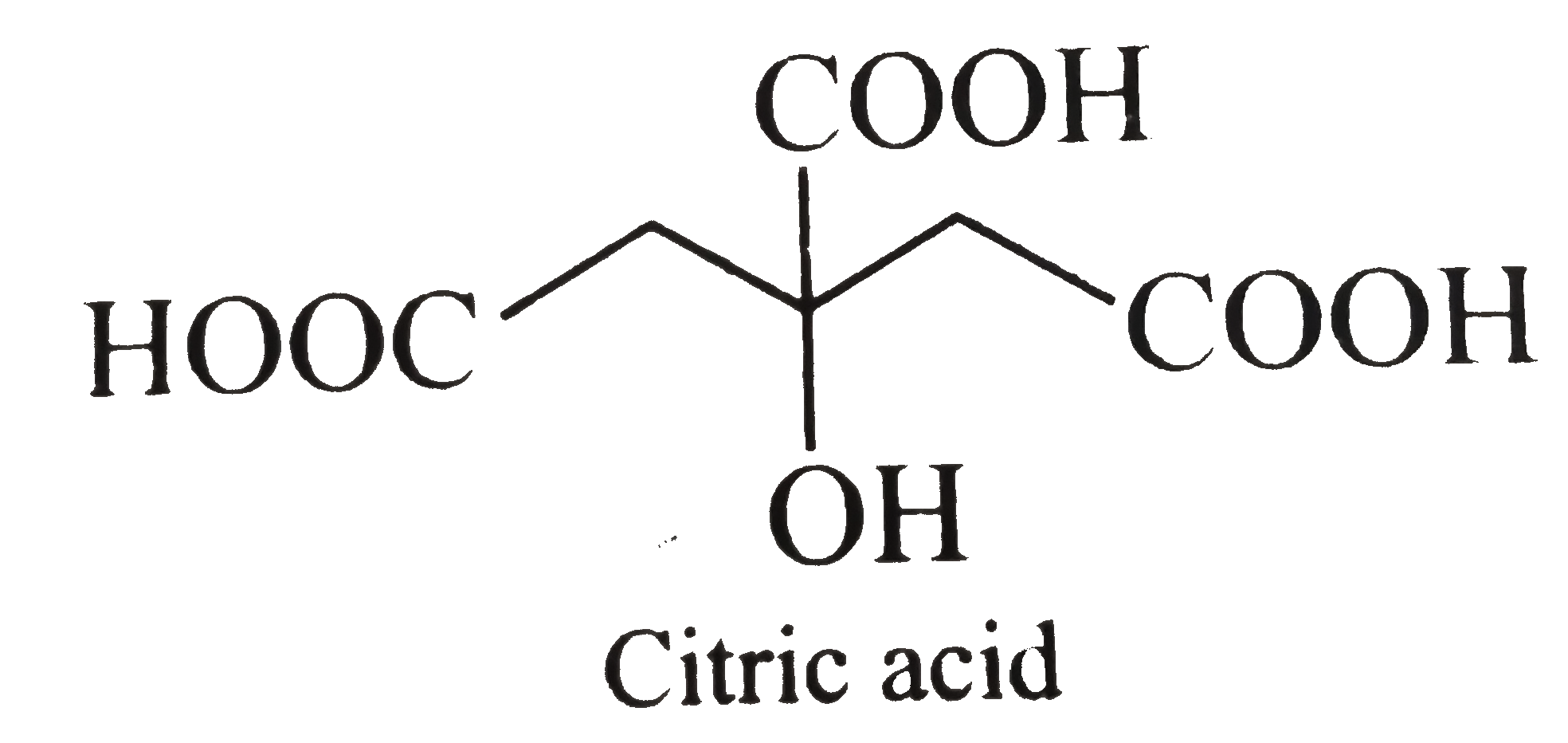Assertion (A) : The IUPAC name of the citric acid is 2-hydroxy-propane-1,2,3-tricarboxylic acid
Reason (R): When an unbranched C atom directly linked to more than two like-functional groups, then it is named as a dervative of the parent alkane which does not include the C of the functional groups.

If both (A) and (R) are correct and (R) is the correct explanation for (A).
If both (A) and (R) are correct and (R) is not the correct explanation.
If (A) is correct and (R) is incorrect.
If both (A) and (R) are incorrect.
The correct Answer is:A
Step by step video & image solution for Assertion (A) : The IUPAC name of the citric acid is 2-hydroxy-propane-1,2,3-tricarboxylic acid Reason (R ): When an unbranched C atom directly linked to more than two like-functional groups, then it is named as a dervative of the parent alkane which does not include the C of the functional groups. by Chemistry experts to help you in doubts & scoring excellent marks in Class 11 exams.
Updated on:21/07/2023Topper's Solved these Questions
- CLASSIFICATION AND NOMENCLATURE OF ORGANIC COMPOUNDSBOOK - CENGAGE CHEMISTRY ENGLISHCHAPTER - CLASSIFICATION AND NOMENCLATURE OF ORGANIC COMPOUNDSEXERCISE - Fill in the Blanks Type
5 Videos
- CLASSIFICATION AND NOMENCLATURE OF ORGANIC COMPOUNDSBOOK - CENGAGE CHEMISTRY ENGLISHCHAPTER - CLASSIFICATION AND NOMENCLATURE OF ORGANIC COMPOUNDSEXERCISE - Analytical and Descriptive Type
3 Videos
- CLASSIFICATION AND NOMENCLATURE OF ORGANIC COMPOUNDSBOOK - CENGAGE CHEMISTRY ENGLISHCHAPTER - CLASSIFICATION AND NOMENCLATURE OF ORGANIC COMPOUNDSEXERCISE - Single correct Answer Type
44 Videos
- CHEMICAL EQUILIBRIUMBOOK - CENGAGE CHEMISTRY ENGLISHCHAPTER - CHEMICAL EQUILIBRIUMEXERCISE - Subjective type
1 Videos
- GENERAL ORGANIC CHEMISTRYBOOK - CENGAGE CHEMISTRY ENGLISHCHAPTER - GENERAL ORGANIC CHEMISTRYEXERCISE - Analytical and Descriptive
1 Videos
Similar Questions
Assertion : The IUPAC name for the compound C6H5COOCH2CH2COOH is 3−benzoyloxypropanoic acid.
Reason :C6H5CH2O is called benzoyloxy group.
View SolutionAssertion (A) IUPAC name of the compound
CH3−CH∣CH3−O−CH2−CH3 is 2-ethoxy-2-methylethane
Reason (R) In IUPAC nonmenclature, ether is regarded as hydrocarbon derivative in which a hydrogen atom is replaced by -OR and or -OAr group [where, R = alkyl group and Ar = aryl group].
View Solution
Knowledge Check
Di-tert-glycols rearrange in the presence of acid to give alpa-tertiary ketones. The trivial name of the simplest glycol of this type is pinacol, and this type of reaction therefore is named pinacol rearrangement (in this specific case, the reaction is called a pinacol-pinacolone rearrangement). The rearrangement involves 4 steps. one of the hydroxyl groups is protonated in the first step. A molecule of water is eliminated in the second step and a tertiary carbocation is formed. The carbocation rearranges in the third step into a more stable carboxonium ion via a [1,2] rearrangement. In the last step, the carboxonium ion is deprotonated and the product ketone is obtained.

What is R.D.S. of pinacol-pinacolone rearrangement?AI stepBII stepCIII stepDIV step
The IUPAC name of [Co(H2NCH2CH2NH2)2(NO2)NO5 is bis(enthane-1,2-diamine) dinitrito-N-cobalt(III) nitrate.It follows the following rules that.
(a)Cation is named first followed by anion.
(b) Ligands are named in an alphabetical order before the name of the central atom/ion.
( c)Name of anionic ligands end in "o" (ex.chlorido) those of neutral (and if cation) ligands are the same except aqua for H2O, ammine for NH3 etc.
(d)Prefixes mono,di,tri,etc.are used to indicate the number of individual ligand.When the name of the ligands include a numerical prefix, then terms bis, tris, tetrakis are used.
(e)Oxidation state of the metal is indicated by Roman numeral in parenthesis.
(f) For cationic and neutral complexes, the metal is named same as the element and for anionic complex, the name of metal ends with suffix-ate.For some metals, the Latin names are used in the complex anions , e.g., ferrate for Fe, argentate for silver etc.
The correct IUPAC name of the coordination compound [Pt(NH3)2Cl(NH2CH3)] is :
View SolutionThe IUPAC name of [Co(H2NCH2CH2NH2)2(NO2)NO5 is bis(enthane-1,2-diamine) dinitrito-N-cobalt(III) nitrate.It follows the following rules that.
(a)Cation is named first followed by anion.
(b) Ligands are named in an alphabetical order before the name of the central atom/ion.
( c)Name of anionic ligands end in "o" (ex.chlorido) those of neutral (and if cation) ligands are the same except aqua for H2O, ammine for NH3 etc.
(d)Prefixes mono,di,tri,etc.are used to indicate the number of individual ligand.When the name of the ligands include a numerical prefix, then terms bis, tris, tetrakis are used.
(e)Oxidation state of the metal is indicated by Roman numeral in parenthesis.
(f) For cationic and neutral complexes, the metal is named same as the element and for anionic complex, the name of metal ends with suffix-ate.For some metals, the Latin names are used in the complex anions , e.g., ferrate for Fe, argentate for silver etc.
The IUPAC name of Fe4[Fe(CN)6]3 is :
View SolutionAssertion (A): 2,6-Dimethyl-4-nitrophenol (I) is more acidic than 3,5-dimethyl-4-nitrophenol (II).
Reason (R ): It is due to the steric inhibition of the resonance of (−NO2) group with two (Me) groups in (II).
View SolutionAssertion (A) IUPAC name of the compound
CH3−CH∣CH3−O−CH2−CH2−CH3 is 2-ethoxy-2-methylethane
Reason (R) In IUPAC nonmenclature, ether is regarded as hydrocarbon derivative in which a hydrogen atom is replaced by -OR and or -OAr group [where, R = alkyl group and Ar = aryl group].
View SolutionThe concept of resonance explains various properties of compounds.The molecules with conjugated system of π bonds, are stabilized by resonace and have low heat of hydrogenation.Hyperconjugative stabilization also decreases heat f hydrogenation.In aromic rings a functional group with a lone pair of electron exerts +m effect. Some functional groups like -NO, -NC, -CH=CH2 can function both as electron releasing (+m,+R) or electron withdrawing (-m,-R) groups.More extended conjugation provides more stabilization.
The correct heat of hydrogenation order is
(p)1,3-Pentadiene , (q)1,3-Butadiene , (r)2,3-Dimethyl-1,3-butadiene , (s)Propadiene
View SolutionGive condensed and bond line structural formulas and identify the functional group(s) present, if any, for :
(a) 2,2,4-Trimethylpentane
(b) 2-Hydroxy-1,2,3-propanetricarboxylic acid
(c) Hexanedial
View SolutionA: The IUPAC name of CH2=CH−C=CH is but-3-en-1-yne.
R: The priority of triple bond is more than double bond
View Solution
